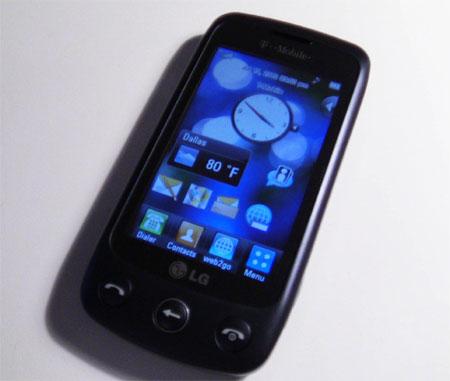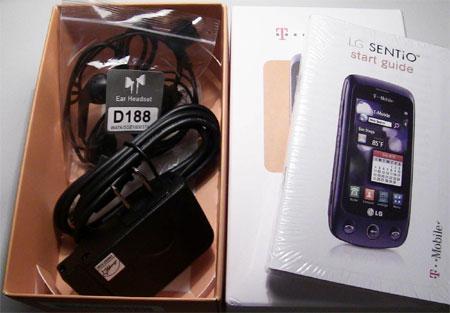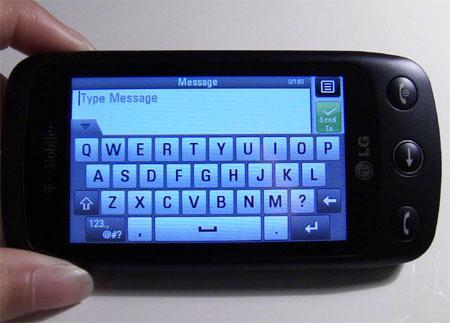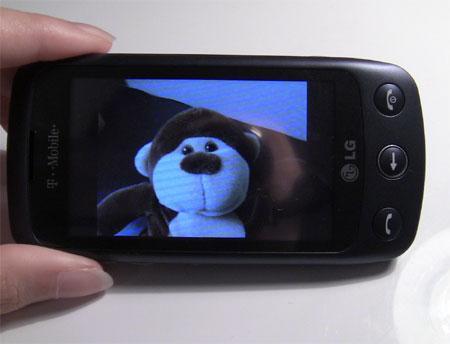
The Good: Widgets on an extended homescreen; 3 megapixel camera; Social Buzz for accessing your social networking feeds; the device feels solid; excellent battery life.
The Bad: Resistive touchscreen gave me a few problems; web browsing was very troublesome.
The Verdict: The LG Sentio is a solid device with great features, including a 3 MP camera. Though the web browsing experience was not pleasant by any means, the device is otherwise fun to use and does its job well.
The Sentio is the first LG phone to be offered from T-Mobile and it's a great start. The device features a 3 MP camera, a 3-inch touchscreen, YouTube player, Google Maps with navigation, and more. It's still a featurephone, but it has a lot to offer and comes in a very sleek and solid package. It doesn't have a physical keyboard, which may turn some people off, but it's definitely fun to use and has all the features you need.
The first word that comes to my mind when I think of the design of the device is 'solid'. I know, I've used that word a couple of times when describing this phone, but it's for a reason. The Sentio is the rare featurephone that doesn't feel hollow and cheap. It feels, well, solid.The device measures 4.21" x 2.07" x .45" and weighs 3.26 ounces. It's a bit narrower than most featerphones and much thinner.

The Sentio ships with the usual accessories - a battery, USB-based modular charger, USB data cable, and a set of standard earbuds with an in-line mic. The Warranty info and Start Guide is tucked away in a pocket behind the cardboard holder for the phone.
Getting back to the device itself, there is no physical keyboard, so you'll be working solely with the 3-inch WQVGA resistive touchscreen. The screen has a resolution of 240 x 400 pixels. Along with the display, the front panel also contains a send/phone button, a back button, and an end/power button. The left side of the phone is where you'll find the volume rocker button, Task Menu button, and the microUSB port. The right side contains only the dedicated camera key and top of the phone contains the screen lock/unlock button. The phone does have a microSD card slot, but it is underneath the battery cover. Phone memory is expandable up to 16 GB.
One of the great things about the Sentio is the homescreen. You can have multiple widgets and the homescreen is expandable. So, even though you don't have 3 homscreens, at least you have more space on the single homscreen you have that you can get to by simply scrolling down. Your widget and icon options include weather, clock, calendar, new text message, Google maps, music player (supports MP3, WMA, AAC, AAC+, MPEG4, etc.), e-mail inbox, YouTube, settings and more. You can, of course, reach these and other features from the menu, which is organized by Phone, Media, Organizer, and Settings. The bottom of the homscreen also contains permanent shortcuts for Dialer, Contacts, web2go, and Menu. The phone also features a Task Menu that you can use for app switching - very handy.

As stated earlier, there is no physical keyboard. The virtual keyboard worked well enough, but I did have trouble with it and usually had several mistakes after typing a message. You can use T9 in portrait mode. I suppose the virtual keyboard performs as well as it can, being on a resistive screen, but that didn't make it any less tedious to type a message and continuously fix my mistakes. The phone does feature threaded text messaging and the interface looked very cool and has a nice design to it.

Another thing that gave me problems was the web browser. The phone does support 3G bands and it's also important to note that these 3G bands are compatible with the 3G bands in Europe, meaning that you will have access to 3G data and speeds if you use the Sentio there. However, having 3G didn't seem to help any as the web browser was extremely slow and half the time didn't even load the page. After doing some research, I found that other people have had this same problem. Loading speeds are very slow and sometimes it just tops in the middle like it just gave up. Web browsing may not be a huge feature on a featurephone and of course you're willing to sacrifice a little bit of quality since you know it's not a smartphone, but the performance was terrible and made the web browser useless.
Moving onto some brighter news, the Sentio has a 3 megapixel camera, something you don't always see on a featurephone these days. Way back when featurephones were the only thing we had, it seemed like they put more work into features like the camera, but now they sometimes just slap on a 1.3 magapixel camera and call it day. It's nice to see a 3 megapixel camera, though the Sentio doesn't have a flash or self-portrait mirror. It does, however, have digital zoom, several shooting modes and color options, and some cool editing features. I was very impressed by this. Picture quality was decent. The phone also captures video.

The battery on the Sentio was absolutely outstanding. It ships with a 900 mAh battery that is estimated to give you 6.1 hours of talk time. In testing, the battery lasted a little over a full week before going dead! And that wasn't entirely on standby because for a couple of those days, I was testing out the web browser, camera, and text messaging. I had no complaints about the battery. It lasted a lot longer than expected and performed well.
Call quality was another thing I had no problems with. Though you're not going to get the same clarity as a smartphone with two microphones, the sound on the Sentio was good enough. Even in high-traffic areas, I could still hear the person I was talking to and they could hear me.
The LG Sentio is a solid device with solid features. Not everyone is a fan of LG and their user interface, but if you're impartial and you want a featurephone that doesn't feel like it's going to fall apart in your purse or pocket, definitely check out the Sentio. It's available now from T-Mobile for $69.99.